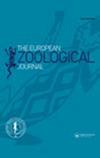Identification and characterization of five polymorphic microsatellite loci in the freshwater copepod Hemidiaptomus gurneyi (Copepoda: Calanoida: Diaptomidae)
引用次数: 5
Abstract
Abstract Hemidiaptomus diaptomid copepods are known to be excellent biological indicators for the highly biodiverse crustacean communities inhabiting Mediterranean temporary ponds (MTPs), an endangered inland water habitat whose conservation is considered a priority according to the “Habitat Directive” of the European Union. This study reports on the characterization of five polymorphic microsatellite loci in Hemidiaptomus gurneyi, to be used as markers for fine-scale studies on the population genetic structure and metapopulation dynamics of a typical and obligate MTP dweller. The five selected loci proved to be polymorphic in the species, with three to five polymorphic loci per studied population. Overall, mean heterozygosity scored for all loci and populations was lower than that reported for the few other diaptomid species for which microsatellite loci have been to date described; this is possibly due to the intrinsically fragmented and isolated peculiar habitat inhabited by the species. Furthermore, the presence of indels within the flanking regions of selected loci was scored. This study, albeit confirming the technical difficulties in finding proper microsatellite markers in copepods, provides for the first time a set of useful polymorphic microsatellite loci for a Hemidiaptomus species, thus allowing the realization of fine-scale phylogeographic and population genetics studies of this flagship crustacean taxon for MTPs.淡水桡足类古尼半爪鱼5个多态微卫星位点的鉴定与特征(桡足目:鱼目:双足目)
地中海临时池塘(MTPs)是一种濒临灭绝的内陆水域栖息地,其保护被欧盟“生境指令”列为优先事项,而半idiaptomus diaptomid桡足类是地中海临时池塘(MTPs)中具有高度生物多样性的甲壳类动物群落的优秀生物指标。本研究报道了五个多态微卫星位点的特征,为典型和专性MTP居民群体遗传结构和超群体动态的精细研究提供了标记。所选的5个位点在该物种中被证明是多态性的,每个研究群体有3到5个多态性位点。总体而言,所有基因座和种群的平均杂合度得分低于迄今为止报道的其他少数有微卫星基因座的双裂目物种;这可能是由于该物种所居住的固有的破碎和孤立的特殊栖息地。此外,在所选位点的侧翼区域内存在的索引被评分。本研究虽然证实了在桡足类动物中寻找合适的微卫星标记的技术困难,但首次为半尖足类物种提供了一组有用的多态微卫星位点,从而实现了对这一主要甲壳类动物MTPs分类群的精细系统地理和群体遗传学研究。
本文章由计算机程序翻译,如有差异,请以英文原文为准。
求助全文
约1分钟内获得全文
求助全文

 求助内容:
求助内容: 应助结果提醒方式:
应助结果提醒方式:


